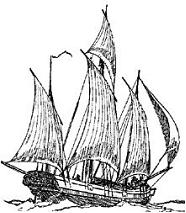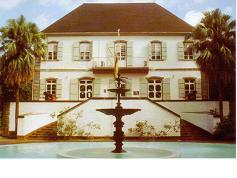





Last Voyage of Le Coureur
The Wreck of a Slave Ship off the Mauritius Coast
View of the wreck site
March 1821. Night had just fallen and there was a full moon. A small lugger was waiting offshore to deliver a cargo of slaves to French colonists residing on the British colony of Mauritius. Unfortunately, the seas were rough, a cyclone having passed through the region only days earlier. Dorval, commanding the small vessel, was an experienced navigator but he could not risk bringing the ship in by day. His cargo – slaves acquired at Madagascar or Mozambique – was strictly illegal, the slave trade having been prohibited by laws sent out to the island from London some years previously. Dorval had to act with caution, and had left word that he would bring in his cargo at night, on 3rd March, choosing the date carefully so as to navigate across the dangerous reefs by the light of a full moon. A fire was lit on shore near the Pointe aux Feuilles, to indicate where Dorval should head to offload the slaves. Unfortunately, the voyage of the Coureur was being tracked by the British navy who dispatched the schooner Henrietta, under the command of Lieutenant Weatherly, to cruise off the eastern shores of Mauritius. Le Coureur was spotted, and as Dorval entered the bay, the lugger crashed into the reefs and was wrecked. Was the rough sea to blame, or had Dorval panicked at the sight of the pursuing British schooner? The slaves were quickly disembarked and the ship was set ablaze to destroy any evidence of the slave trade. It is not known whether anyone lost their life in the shipwreck.
was waiting offshore to deliver a cargo of slaves to French colonists residing on the British colony of Mauritius. Unfortunately, the seas were rough, a cyclone having passed through the region only days earlier. Dorval, commanding the small vessel, was an experienced navigator but he could not risk bringing the ship in by day. His cargo – slaves acquired at Madagascar or Mozambique – was strictly illegal, the slave trade having been prohibited by laws sent out to the island from London some years previously. Dorval had to act with caution, and had left word that he would bring in his cargo at night, on 3rd March, choosing the date carefully so as to navigate across the dangerous reefs by the light of a full moon. A fire was lit on shore near the Pointe aux Feuilles, to indicate where Dorval should head to offload the slaves. Unfortunately, the voyage of the Coureur was being tracked by the British navy who dispatched the schooner Henrietta, under the command of Lieutenant Weatherly, to cruise off the eastern shores of Mauritius. Le Coureur was spotted, and as Dorval entered the bay, the lugger crashed into the reefs and was wrecked. Was the rough sea to blame, or had Dorval panicked at the sight of the pursuing British schooner? The slaves were quickly disembarked and the ship was set ablaze to destroy any evidence of the slave trade. It is not known whether anyone lost their life in the shipwreck.
Back on shore, the British authorities ordered a search to be made for the newly disembarked slaves and the lugger’s crew, offering a reward of $1000. But this was one of many such investigations for which limited manpower was available. The lugger’s captain, Dorval Letord escaped to the sister island of Bourbon [now known as Réunion]. Eventually 41 of the hundred or so slaves believed to have been on board Le Coureur were found. Unfortunately, this would not have meant an end to servitude for the hapless slaves. It was usual practice at this time to hand over ‘liberated’ slaves to new owners who would ‘apprentice’ them to various trades for periods of service as long as 14 years. In reality, their fate, at least for a decade or more, would not be so very different from that of other slaves on the island. Dorval would eventually return to Mauritius, turn King’s Evidence, and supply much useful evidence about how the illegal slave trade was operated on the island.
Meanwhile the wreck of Le Coureur a 50-ton, Mauritius built lugger, would lie undiscovered and unexplored for almost two centuries.
The story of those dramatic events in March 1821 would begin their gradual return to public consciousness on 10th October 2004, when Mr A.V. Naiken, a diver at the Fish Farm of Mahébourg off the south-eastern coast of Mauritius, spotted the outline of a shipwreck, and reported his find to the relevant authorities.
The local underwater archaeologist Mr Yann von Arnim of the Mauritius Marine Conservation Society (MMCS) and the Mauritius Museums Council worked with Mr Ibrahim Ahmed Metwalli, a maritime archaeologist from the Department of Underwater Archaeology of the Egyptian Supreme Council of Antiquities and Mr Nicolas Bigourdan, a French maritime archaeologist, to explore the wreck site in 2005 and 2006.
 The key objectives of the archaeological campaign were to identify the wreck and retrieve any artefacts. The wooden hull was partially buried by ballast stones and sediment, which had helped to preserve it. Evidence of fire damage helped to indicate the identity of the ship as Le Coureur. Items retrieved on site were also dated to the relevant time period for the construction and service of the lugger. The artefacts collected were handed over to the National History Museum at Mahébourg and some can be seen on display at the exhibition named ‘The wreck of Le Coureur, a testimony of the illegal slave trade’.
The key objectives of the archaeological campaign were to identify the wreck and retrieve any artefacts. The wooden hull was partially buried by ballast stones and sediment, which had helped to preserve it. Evidence of fire damage helped to indicate the identity of the ship as Le Coureur. Items retrieved on site were also dated to the relevant time period for the construction and service of the lugger. The artefacts collected were handed over to the National History Museum at Mahébourg and some can be seen on display at the exhibition named ‘The wreck of Le Coureur, a testimony of the illegal slave trade’.
 Among the most interesting artefacts retrieved are those suggestive of the purpose of the lugger’s last voyage – the slave trade. Some iron rings set in concrete might have been used to chain slaves. In addition, two lead disks were recovered with a hole at one edge which may have been worn by slaves as a medal or tag for identification purposes. Dorval himself later gave evidence that such tags or labels had been used in the slave trade between Madagascar, Mozambique and Mauritius.
Among the most interesting artefacts retrieved are those suggestive of the purpose of the lugger’s last voyage – the slave trade. Some iron rings set in concrete might have been used to chain slaves. In addition, two lead disks were recovered with a hole at one edge which may have been worn by slaves as a medal or tag for identification purposes. Dorval himself later gave evidence that such tags or labels had been used in the slave trade between Madagascar, Mozambique and Mauritius.
There is evidence of the tags worn by slaves on voyages in some depictions of the ‘middle passage’ across the Atlantic (see picture below).
These can be described as ‘transfer tags’ to distinguish them from those worn by slaves employed on particular works and which would have been used over a longer period of time [see the relevant article on slave tags recovered on Mauritius on this web site].
Pictures of the wreck site ©Yann Vann Arnim
Text ©Marina Carter
For further information about Le Coureur see:
Guillaume Gouges, ‘Sonder les abîmes de l’épave de Pointe-aux-Feuilles’ Express 22
June 2005
Cader Kalla ‘Illegal slave trade’ Weekend, 12 June 2005’
‘Interim Report of the Pointe aux Feuilles’s Wreck (Mauritius): Le Coureur (1818),
an illegal slave trader?’ 2008 www.mmcs-ngo.org
Nathalie Rose ‘Le Coureur entre deux eaux’ Express 5 June 2005
———————————————————————————————–
© MauritiusMag
Leave a Reply